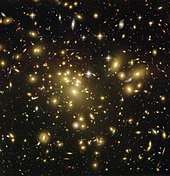Abell 1689
Abell 1689 is a galaxy cluster in the constellation Virgo nearly 2.2 billion light-years away.
| Abell 1689 | |
|---|---|
 | |
| Observation data (Epoch J2000) | |
| Constellation(s) | Virgo |
| Right ascension | 13h 11m 34.2s[2] |
| Declination | −01° 21′ 56″ |
| Richness class | 4[3] |
| Bautz–Morgan classification | II-III[3] |
| Redshift | 0.1832[2] |
| Distance (co-moving) | 754 Mpc (2,459 Mly) h−1 0.705[2] |
| X-ray flux | (14.729 ± 8.1%)×10−11 erg s−1 cm−2 (0.1–2.4 keV)[2] |
Details
Abell 1689 is one of the biggest and most massive galaxy clusters known and acts as a gravitational lens, distorting the images of galaxies that lie behind it.[4] It has the largest system of gravitational arcs ever found.[5]
Abell 1689 shows over 160,000 globular clusters, the largest population ever found.[6]
There is evidence of merging and gases in excess of 100 million degrees.[5] The very large mass of this cluster makes it useful for the study of dark matter and gravitational lensing.[7][8]
At the time of its discovery in 2008, one of the lensed galaxies, A1689-zD1, was the most distant galaxy found.[9][10]
Gallery
 Yellow galaxies belong to the cluster itself. Red and blue are background galaxies gravitationally lensed.
Yellow galaxies belong to the cluster itself. Red and blue are background galaxies gravitationally lensed. Mass map of Abell 1689.
Mass map of Abell 1689. Globular clusters in Abell 1689
Globular clusters in Abell 1689
gollark: With:* static typing* non-manual memory management
gollark: You can *reduce* them, though.
gollark: Yes, which means it probably has billions of subtle bugs in it.
gollark: Not *as much*.
gollark: C++ = C with random junk on top.
References
- "New Hubble image of galaxy cluster Abell 1689". ESA/Hubble Press Release. Retrieved 14 September 2013.
- "NASA/IPAC Extragalactic Database". Results for Abell 1689. Retrieved 2012-03-17.
- Abell, George O.; Corwin, Harold G., Jr.; Olowin, Ronald P. (May 1989). "A catalog of rich clusters of galaxies" (PDF). Astrophysical Journal Supplement Series. 70 (May 1989): 1–138. Bibcode:1989ApJS...70....1A. doi:10.1086/191333. ISSN 0067-0049. Retrieved March 12, 2012.
- Falcon-Lang, Howard (19 August 2010). "Fate of Universe revealed by galactic lens". BBC News. BBC. Archived from the original on 19 August 2010. Retrieved 19 August 2010.
- "Purple Haze, Part Deux". NASA. 12 September 2008. Retrieved 19 September 2012.
- "Globular clusters within Abell 1689". HUBBLE/ESA. 12 September 2013. Retrieved 19 September 2013.
- "Detailed Dark Matter Map Yields Clues to Galaxy Cluster Growth". NASA. 11 December 2010. Retrieved 19 September 2012.
- Diego, Jose M.; Broadhurst, T.; Benitez, N.; Umetsu, K.; Coe, D.; Sendra, I.; et al. (2014). "A Free-Form Lensing Grid Solution for A1689 with New Multiple Images". MNRAS. 446 (1). arXiv:1402.4170. Bibcode:2015MNRAS.446..683D. doi:10.1093/mnras/stu2064.
- "Astronomers Eye Ultra-Young, Bright Galaxy in Early Universe". nasa.gov. 2008-02-12. Retrieved 2008-02-25.
- "Astronomers Uncover One of the Youngest and Brightest Galaxies in the Early Universe". Space Telescope Science Institute Baltimore, Md. / nasa.gov. 2008-02-12. Archived from the original on 17 February 2008. Retrieved 2008-02-25.
External links
| Wikimedia Commons has media related to Abell 1689. |
- Galaxy cluster Abell 1689: Biggest 'Zoom Lens' in Space Takes Hubble Deeper into the Universe (HubbleSite)
- Galaxy cluster Abell 1689: Astronomers Find One of the Youngest and Brightest Galaxies in the Early Universe (HubbleSite)
- Astronomers take a step towards revealing the Universe's biggest mystery, ESA/Hubble Press Release.
This article is issued from Wikipedia. The text is licensed under Creative Commons - Attribution - Sharealike. Additional terms may apply for the media files.